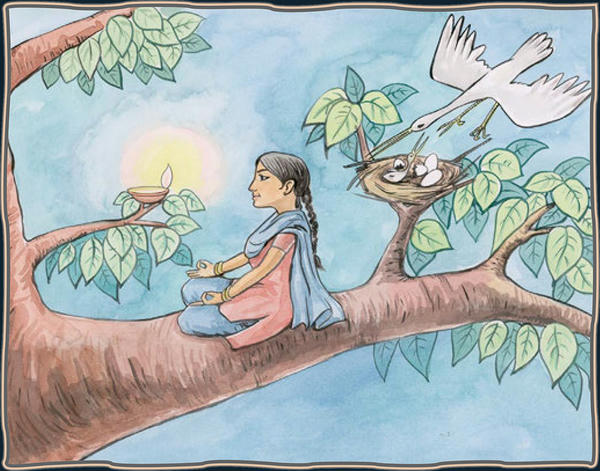
Climbing even higher, the girl sits before a small oil lamp. She is focusing, concentrating, on the flame, thinking of nothing else, not letting her mind wander to any other object, idea, sensation or memory. Behind her, a heron is concentrating on the full-time job of feeding its newly hatched fledglings.§
When we have brought awareness to attention, we automatically move into the next step, concentration. The hummingbird, poised over the flower, held at attention, begins to look at the flower, to concentrate on it, to study it, to muse about it, not to be distracted by another flower—that is, then, awareness moving. Awareness distracted, here, is awareness simply moving to another flower, or moving to another area of the mind.§
Give up the idea that thoughts come in and out of your mind like visitors come in and out of your house. Hold to the idea that it is awareness that moves, rather than the thoughts that move. Look at awareness as a yo-yo at the end of a string. The string is hooked to the very core of energy itself, and awareness flows out and it flows in. Awareness might flow out toward a tree and in again, and then out toward a flower and then in again, and down toward the ground and then in again. This wonderful yo-yo of awareness—that is a good concept to grasp in order to become more acquainted with awareness. Awareness held at attention can then come into the next vibratory rate and concentrate.§
Here is a simple concentration exercise. Take a flower and place it in front of you. Breathe deeply as you sit before it. Simply look at it. Don’t stare at it and strain your eyes. Simply become aware of it. Each time awareness moves to some other area of the mind, with your willpower move awareness back and become aware of the flower again. Keep doing this until you are simply aware of the flower and not aware of your body or your breath. Then begin to concentrate on the flower. That is the second step. Think about the flower. Move into the area of the mind where all flowers exist in all phases of manifestation, and concentrate on the flower. Move from one area to another—to where all stems exist, to the stem of that particular flower, to the root that that particular flower came from, and to the seed. Concentrate, concentrate, concentrate on the flower. This is what concentration is—remaining in the thought area of the particular item that you are aware of and flowing through the different color and sound vibrations of the thoughts. How does it work? The powers of concentration—it is only a name. Actually, what is happening is you are flowing awareness through the area of the mind which contains the elements which actually made that particular flower, and you are perceiving how all those elements came together. If you can concentrate sufficiently to have fifty thoughts about the flower without a single thought about anything else, you will have mastered dhārana.§

